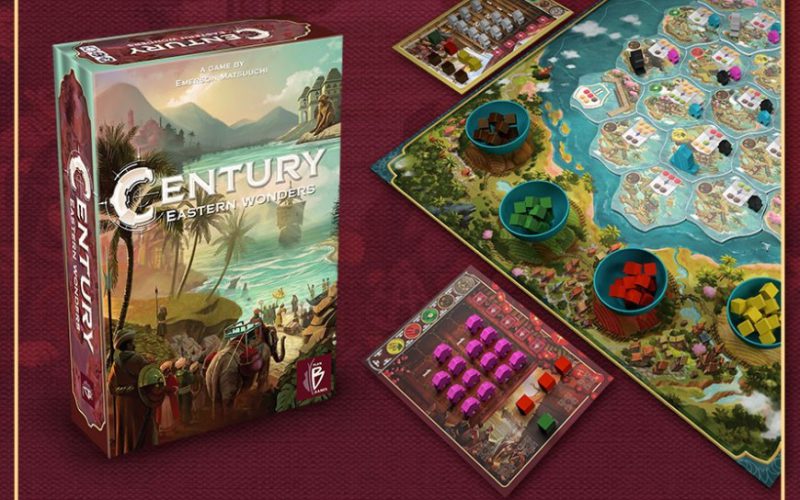This game review was originally published in Tumbleweird in September 2018.
For many, last year’s Century: Spice Road replaced Splendor as the de facto simple-to-learn engine building game. Earlier this year, Plan B Games released the second title in the Century Trilogy: Eastern Wonders.
In Eastern Wonders, players resume the role of spice merchants and make their way onto the high seas, hopping from island to island trading one kind of spice for another and ultimately fulfilling contracts that will earn you sweet, sweet victory points. Players move their ship around the island tiles, place trading posts, and work to upgrade their ship in order to gain advantage over their competitors. The first player to fulfill four contracts triggers the end-game round, after which the player who has earned the most victory points claims the win.
Component-wise, Eastern Wonders comes through with dozens of wooden trading post bits, and bowls brimming with colored cubes for spices. Tokens are sturdy chipboard and punched cleanly. Player tableaus are made out of cardstock and are susceptible to early warping so store them resting between to two rule sheets to keep them flat.
The best thing out of the box, though, are the island tiles that players use to make up the playspace their ships will travel on. While Eastern Wonders comes with a suggested series of ocean maps, the swirled-hexagonal tiles can be configured in any way players like, adding a huge amount of variety to the game. With the amount of player contact the island tiles have, a design that allowed them to lock together a little more would prevent the tiles from getting more and more askew as the game progresses, but the gorgeous (optional, purchased separately) neoprene mat helps set up and in-game stability tremendously.
Eastern Wonders works, and I enjoyed playing it, but the gem here is playing Eastern Wonders as an expansion to Century: Spice Road. For players who own the first game in the series, Eastern Wonders comes with an alternate ruleset allowing the games to be played together as a third game: From Sand to Sea. By taking the trading deck from Spice Road, flipping over the player tableaus to a side meant for From Sand to Sea and learning a couple of additional rules, players are introduced to a much deeper and far more enjoyable gaming experience than either of the Century games alone. After playing the combined games, I haven’t found reason to play either game separately, and if possible will only teach From Sand to Sea to new players.
If you don’t have a copy of Century: Spice Road, I would still recommend picking up Eastern Wonders. If you like it, grab Spice Road and combine the games. Additionally, by having both of the Century games, you’ll be entirely prepared for next year when the third and final game in the trilogy is released. Will the complete trilogy (and final combined gestalt game) be worth the wait and investment? If it continues the quality and gameplay I’ve already seen from the Century series I have little doubt that it will.
Designed by: Emerson Matsuuchi
Player Count: 2-4
Playtime: 45-75 minutes
Time to Learn: 15 minutes
Complexity: 2.5/5
Replayability: 4/5
MSRP: $40 + $30 for the (pictured) neoprene mat.
Will my mom play it?: Yup. Though, we haven’t tried the combined game yet.
Am I happy I bought it?: Yup.
I purchased this game from Adventures Underground because they’re awesome. Neoprene mat was purchased as a gift by a fellow TAG member (Thanks, Art!).
Written by Brendan Quinn; President of Tri-City Area Gaming. Learn more about the 200+ annual gaming events we host by visiting http://www.tricityareagaming.com.

